weight MERCEDES-BENZ METRIS 2021 MY21 Operator's Manual
[x] Cancel search | Manufacturer: MERCEDES-BENZ, Model Year: 2021, Model line: METRIS, Model: MERCEDES-BENZ METRIS 2021Pages: 290, PDF Size: 4.68 MB
Page 136 of 290
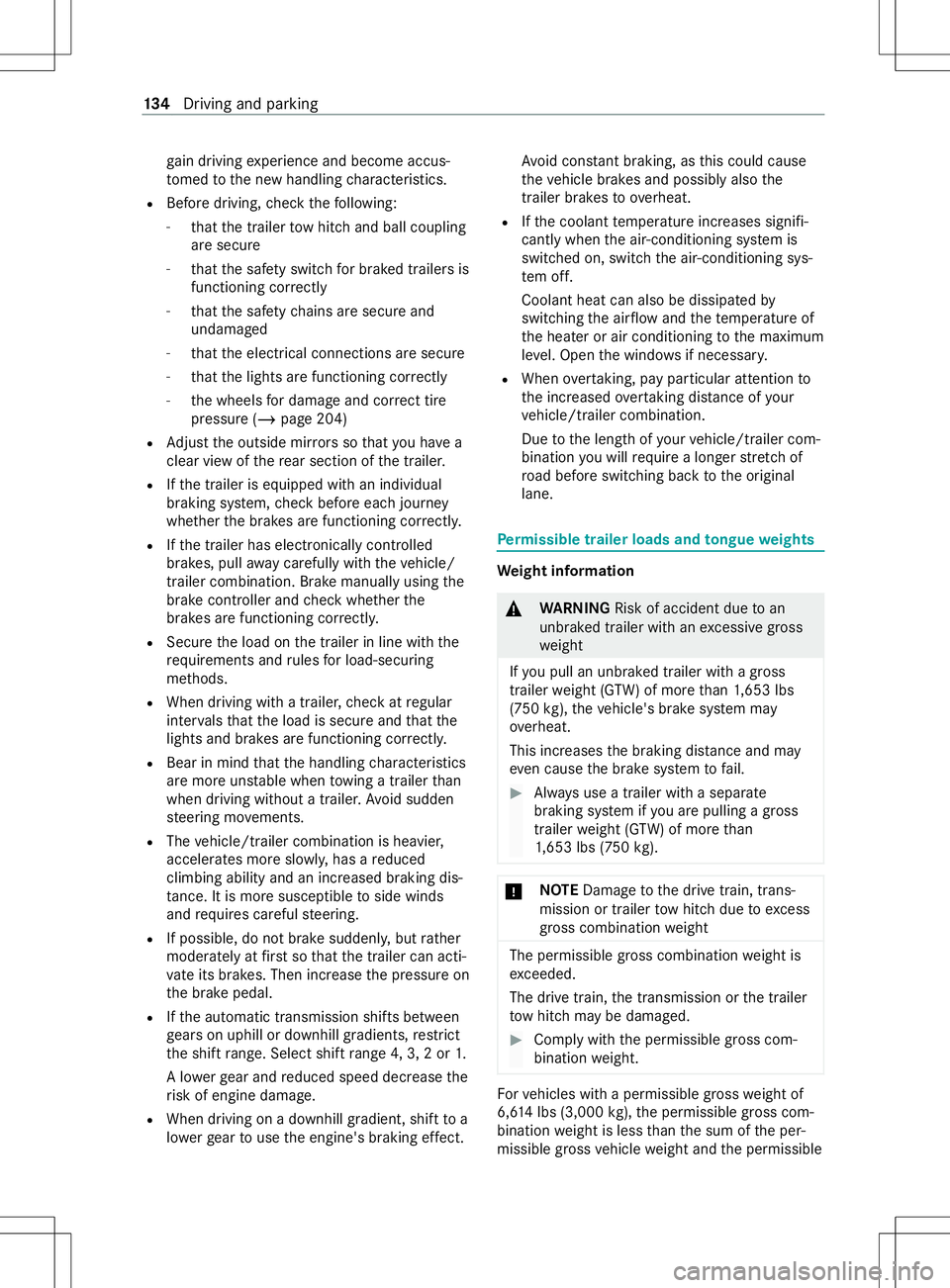
ga
in driving experience and become accus‐
to med tothen ew handling characteristics.
R Befor edriving, checkt he following:
- that thet railer towh itch and ball coupling
ar es ecure
- that thes afet ys wit ch forb rake dt railer sis
functioning cor rectly
- that thes afet yc hains ar esecur eand
undamaged
- that thee lectrical connection saresecure
- that thel ights ar efunctioning cor rectly
- thew heels ford ama geand cor rect tire
pressur e(/ page 204)
R Adjus tthe outside mir rors so that youh ave a
clea rviewoft herear sectio nofthe trailer.
R Ifth et railer is equipped wit hanindividual
braking sy stem, checkb efor eeachj ourney
whe ther theb rake sa refunctioning cor rectl y.
R Ifth et railer has electronicall ycont rolled
brakes, pull away carefully wi th thevehicle/
trailer combination .Brake manually using the
brak econtroller and checkw hether the
brakes ar efunctioning cor rectl y.
R Secu rethel oad on thet railer in line wit hthe
re qu irements and rules forl oad-securing
me thods.
R When driving wit hatrailer ,chec katr egular
inter vals that thel oad is secur eand that the
light sand brakes ar efunctioning cor rectl y.
R Bea rinm indthat theh andling characteristics
ar em oreu nstable when towing atrailer than
when drivin gwithout atrailer .Avoid sudden
st eering mo vements.
R The vehicle/trailer combination is heavier,
accelerates mor eslowl y,has areduced
climbing ability and an increased braking dis‐
ta nce. It is mor esusceptible toside winds
and requ ires careful steering.
R If possible, do no tbrake suddenl y,but rath er
moderatel yatfirst so that thet railer can acti‐
va te its brakes. Then inc rease thep ressur eon
th eb rake pedal.
R Ifth ea utomatic transmission shifts between
ge arsonu phill or downhill gradients, restrict
th es hiftrange. Select shif trang e4,3,2or1.
Al owe rgear and reduced speed decrease the
ri sk of engine damage.
R When driving on adownhill gradient, shif ttoa
lo we rgear touse thee ngine' sbraking ef fect. Av
oid cons tant braking, as this could cause
th ev ehicle brakes and possibly also the
traile rbrake stoo verheat.
R Ifth ec oolant temp eratur eincreases signifi‐
cant lywhen thea ir-conditionin gsystemis
switched on, switc hthe air-conditioning sys‐
te mo ff.
Coolant heat can also be dissipated by
switching thea irflow and thet emperatur eof
th eh eater or air conditioning tothem aximum
le ve l. Open thew indo wsif necessar y.
R When overtak ing, pa yparticular attention to
th ei ncreased overtakin gdista nce of your
ve hicle/trailer combination.
Due tothel engt hofy ourvehicle/trailer com‐
bination youw illrequ ireal onger stre tchof
ro ad befor eswit ching bac ktothe original
lane. Pe
rm issible trailer loads and tongue weights We
ight information &
WARNING Risk of accident du etoan
unbraked trailer wit hanexcessiv egross
we ight
If yo up ull an unbraked trailer wit hagross
tr ailer weight (G TW)ofm oret han 1,653 lbs
(750 kg),th ev ehicle's brak esystem may
ove rheat.
This increases theb raking dis tance and may
eve ncause theb rake system tofail. #
Alwaysu seatrailer wit haseparate
braking sy stem if youa repullin gagross
trailer weight (G TW)ofm oret han
1, 653 lbs (750 kg). *
NO
TEDama getothed rive train, trans‐
mission or trailer towh itch due toexc ess
gross combination weight The permissible
grosscombination weight is
exc eeded.
The driv etrain, thet ransmission or thet railer
to wh itch ma ybed amaged. #
Compl ywitht he permissible gross com‐
bination weight. Fo
rv ehicles wit hapermissible gross weight of
6,6 14 lbs (3,00 0kg),thep ermissible gross com‐
bination weight is less than thes um of thep er‐
missible gross vehicle weight and thep ermissible 134
Driving and pa rking
Page 137 of 290
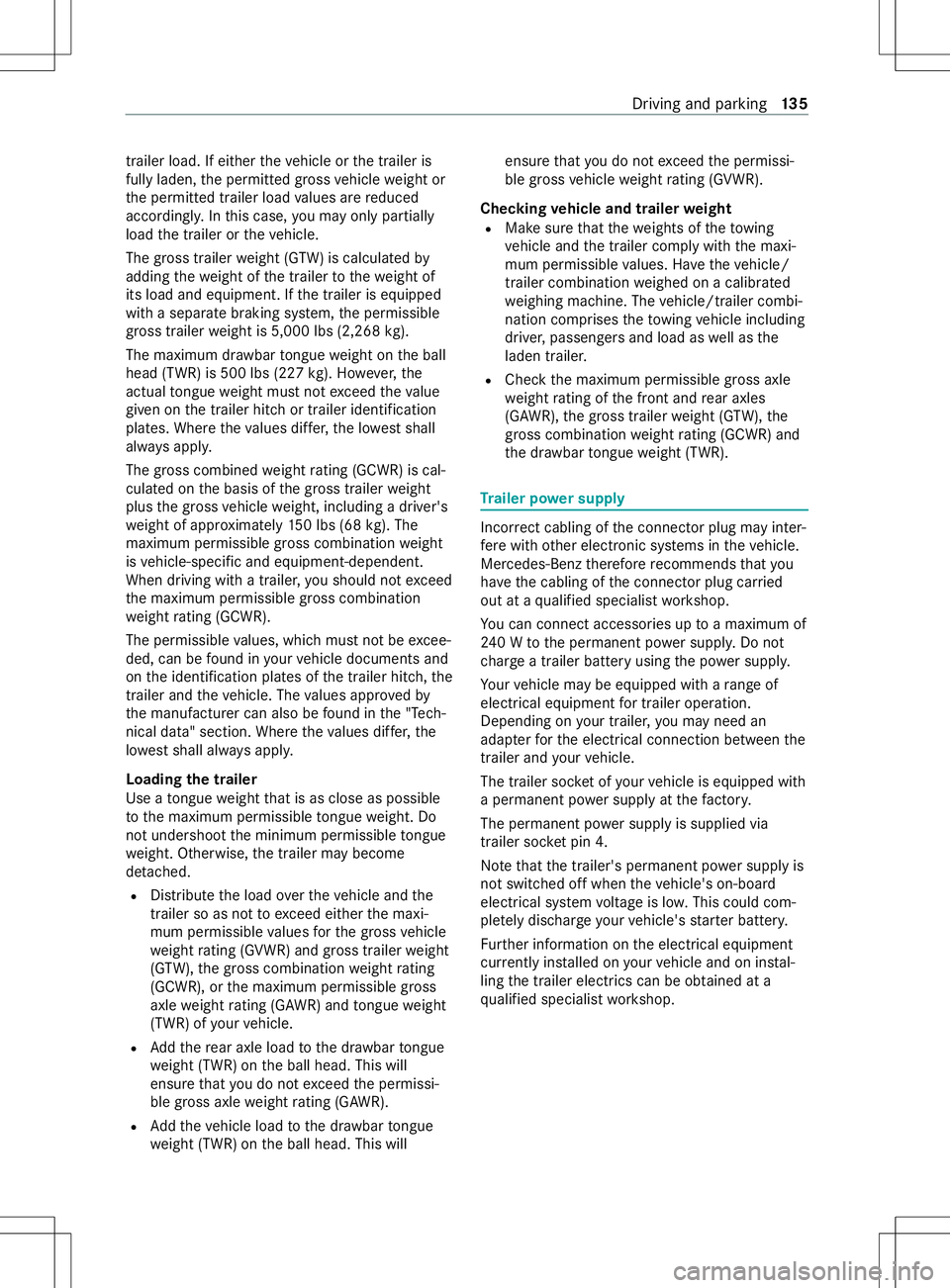
traile
rload. If either thev ehicle or thet railer is
fully laden, thep ermitted gross vehicle weight or
th ep ermitted trailer load values ar ereduced
accordingly .Inthis case, youm ayonly partially
load thet railer or thev ehicle.
The gross trailer weight (G TW)isc alculated by
addin gthe weight of thet railer tothew eight of
its load and equipment. If thet railer is equipped
wit has eparat ebraking sy stem, thep ermissible
gross trailer weight is 5,00 0lbs (2,26 8kg).
The maximum dr awbar tongu eweight on theb all
head (TWR) is 500 lbs (22 7kg). Ho wever,the
actual tongu eweight mus tnotexc eed thev alue
given on thet railer hitc hortrailer identification
plates. Wher ethe values dif fer, th el owest shall
alw aysa pply.
The gross combined weight rating (GCWR) is cal‐
culated on theb asis of theg ross trailer weight
plus theg ross vehicle weight ,including adrive r's
we ight of appr oximately 150lbs (68 kg). The
maximum permissible gross combination weight
is vehicle-specific and equipment-dependent.
When driving wit hatrailer ,you should no texceed
th em aximum permissible gross combination
we ight rating (GCWR).
The pe rmissible values, whic hmustn otbe exc ee‐
ded, can be found in your vehicle documents and
on thei dentification plates of thet railer hitch, the
traile rand thev ehicle. The values appr oved by
th em anufacturer can also be found in the" Tech‐
nical data" section. Wher ethe values dif fer, the
lo west shall alw aysa pply.
Loading thet railer
Use atongue weight that is as close as possible
to them aximum permissible tongu eweight. Do
no tu ndershoo tthe minimum permissible tongue
we ight .Otherwise, thet railer ma ybecome
de tach ed.
R Distribut ethe load overthe vehicle and the
traile rsoasn ot toexceed either them axi‐
mum permissible values fort he gross vehicle
we ight rating (GVWR )and gross traile rweight
(G TW ),th eg ross combination weight rating
(GCWR) ,orthe maximum permissible gross
axle weight rating (G AWR) and tongu eweight
(TWR) of your vehicle.
R Addthe rear axle load tothed rawbar tongue
we ight (TWR) on theb all head. This will
ensur ethat youdon ot exceed thep ermissi‐
ble gross axle weight rating (G AWR).
R Addthe vehicle load tothed rawbar tongue
we ight (TWR) on theb all head. This will ensur
ethat youdon ot exceed thep ermissi‐
ble gross vehicle weight rating (GVWR).
Che cking vehicl eand traile rweight
R Mak esuret hat thew eights of thet ow ing
ve hicle and thet railer comply wit hthe maxi‐
mum permissible values. Ha vethev ehicle/
trailer combination weighed on acalibrated
we ighing machine. The vehicle/trailer combi‐
nation comprises thet ow ing vehicle including
driver ,passenger sand load as well as the
laden trailer.
R Chec kthe maximum permissible gross axle
we ight rating of thef ront and rear axles
(GAWR), theg ross trailer weight (G TW),the
gros scombination weight rating (GCWR) and
th ed rawbar tongu eweight (TWR). Tr
aile rpower supp ly Incor
rect cabling of thec onnector plug ma yinter‐
fe re wit ho ther electronic sy stems in thev ehicle.
Mercedes-Ben ztherefor erecommends that you
ha ve thec abling of thec onnector plug car ried
out at aqualified specialis tworks hop.
Yo uc an connec taccesso ries up toam aximum of
24 0Wtot he permanent po wersupply .Don ot
ch arge atrailer batter yusingthe po wersupply.
Yo ur vehicle ma ybeequipped wit harangeof
electrica lequ ipment fort railer operation.
Depending on your trailer ,you ma yneedan
adap terf or thee lectrical connection between the
traile rand your vehicle.
The trailer soc ketofy ourvehicle is equipped with
ap ermanent po wersupply at thef actor y.
The permanent po wersupply is suppliedv ia
trailer soc ketp in4.
No tethat thet railer's permanen tpowe rsupp lyis
no ts witched of fwhen thev ehicle's on-board
electrical sy stem voltag eisl ow.This could com‐
ple tely discharg eyour vehicle's star terb atter y.
Fu rther information on thee lectrical equipment
cur rentl yins talled on your vehicle and on ins tal‐
ling thet railer electrics can be obtained at a
qu alified specialis tworks hop. Driving and parking
13 5
Page 168 of 290
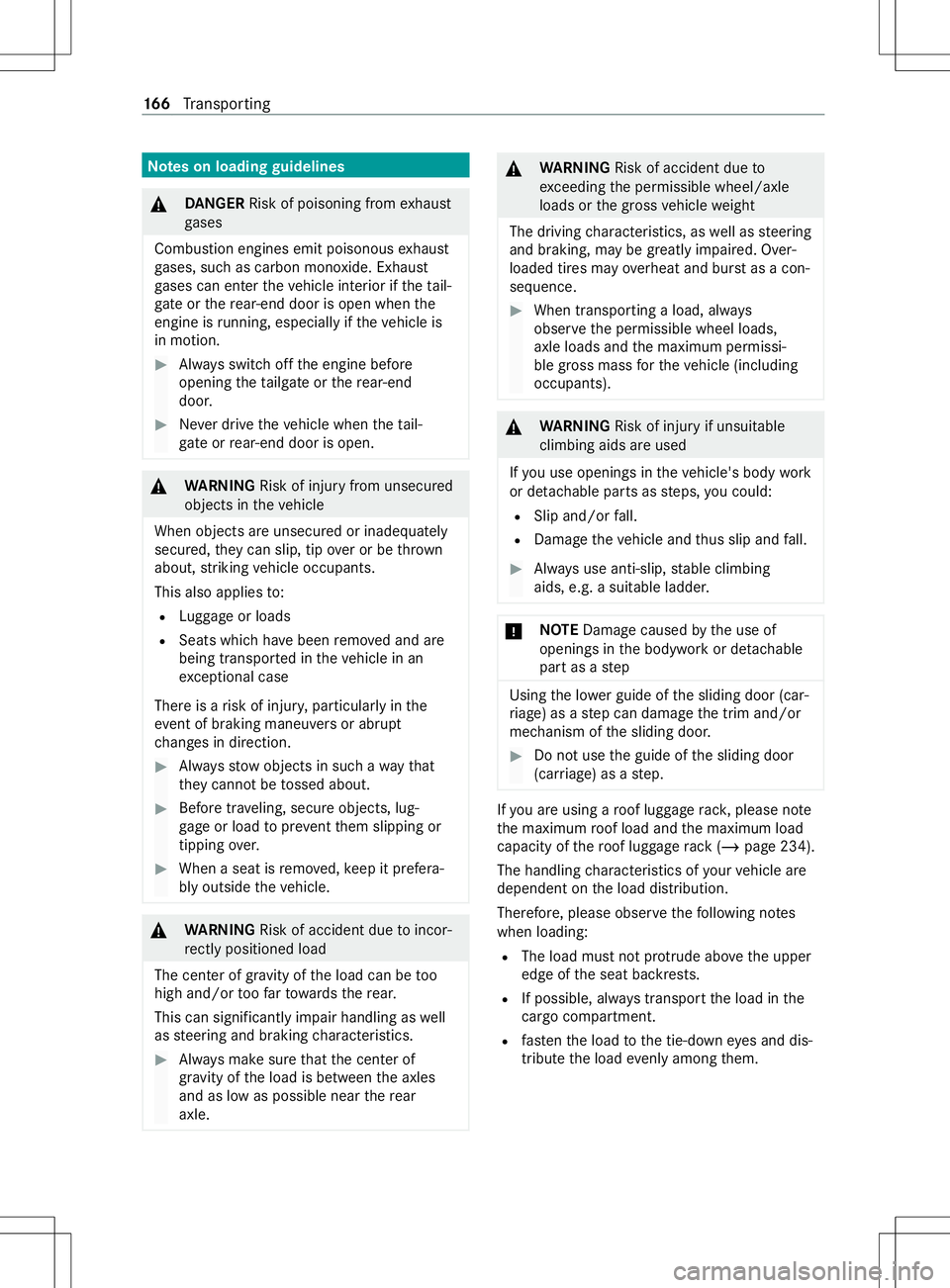
Note
sonl oading guidelines &
DANG ER Risk of poisonin gfrome xhau st
ga ses
Combustion engines emit poisonous exhaust
ga ses, suc hascarbon monoxide. Exhaust
ga ses can enter thev ehicle interior if thet ail‐
gate orther ear-end door is open when the
engine is running ,especial lyifth ev ehicle is
in motion. #
Alwayss witc hoffthee ngine before
opening thet ailgat eortherear-end
door. #
Neverd rive thev ehicle when thet ail‐
ga te or rear-en ddoor is open. &
WARNING Risk of inju ryfrom unsecu red
object sinthevehicle
When objects ar eunsecured or inadequately
secured, they can slip, tip overorbet hrown
about, striking vehicle occupants.
This also appliest o:
R Luggag eorl oads
R Seats whic hhave been remo veda nd are
being transpor tedint hevehicle in an
ex ceptiona lcase
The reisar isk of injur y,particular lyin the
eve nt of braking maneuver sorabrupt
ch anges in direction. #
Alwayss towo bjectsins uchaw aythat
th ey canno tbetossed about. #
Befor etrave ling, secur eobjects, lug‐
ga ge or load topreve ntthem slipping or
tipping over. #
When aseat is remo ved, keep it prefera‐
bly outside thev ehicle. &
WARNING Risk of accident du etoincor‐
re ctly positioned load
The center of gr avity of thel oad can be too
high and/or toof ar towa rdst he rear.
This can significantl yimp air handlin gaswell
as steering and braking characteristics. #
Alwaysm akes uret hat thec enter of
gr av ity of thel oad is between thea xles
and as lo waspossible near ther ear
axle. &
WARNING Risk of accident du eto
exc eeding thep ermissible wheel/axle
loads or theg ross vehicle weight
The driving characteristics, as well as steering
and braking, ma ybegreatl yimp aired. Over‐
loaded tires ma yoverheat and bur stas ac on‐
sequence. #
When transpo rting aload, alw ays
obser vethep ermissible wheel loads,
axle loads and them aximum permissi‐
ble gross mass fort he vehicle (including
occupants). &
WARNING Risk of inju ryif unsuitable
climbin gaids ar eused
If yo uu se opening sinthevehicle's body work
or de tach able parts as steps, youc ould:
R Slip and/or fall.
R Damag ethe vehicle and thus slip and fall. #
Alwaysu se anti-slip, stable climbing
aids, e.g .asuitable ladder. *
NO
TEDama gecaused bytheu se of
openings in theb odywor kordetachable
par tasa step Using
thel owe rguide of thes liding door (car‐
ri age) as astepc an damag ethe trim and/or
mechanism of thes liding door. #
Do no tuse theg uide of thes liding door
(car riage) as astep. If
yo ua reusin gar oof luggag erack, please no te
th em aximum roof load and them aximum load
capacity of ther oof luggag erack( / pag e234).
The handling characteristic sofyourvehicle are
dependent on thel oad distribution.
Therefore, please obser vethef ollowing no tes
when loading:
R The load mus tnotprotru de abo vetheu pper
edg eoft he seat backrests.
R If possible, alw ayst ranspor tthe load in the
cargo compa rtment.
R fastenthel oad tothet ie-down eyes and dis‐
tribut ethe load evenl yamong them. 16 6
Transporting
Page 169 of 290
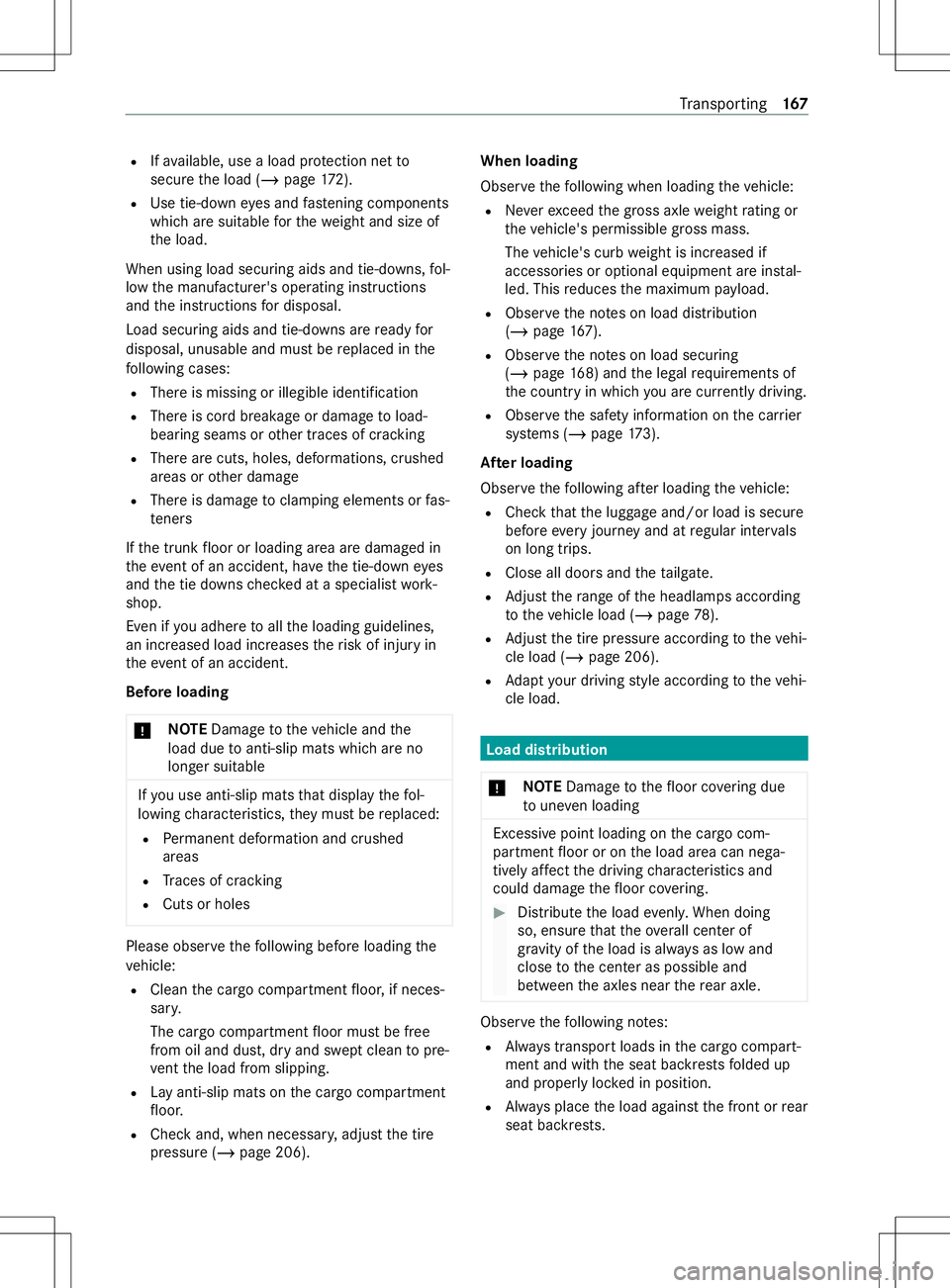
R
Ifav ailable, use aload pr otection ne tto
secur ethe load (/ page172).
R Usetie-down eyes and fastening components
whic haresuitable fort he weight and size of
th el oad.
When using load securing aids and tie-downs, fol‐
lo wt he manufacturer's operating instructions
and thei nstruction sfor disposal.
Load securing aids and tie-d owns ar eready for
disposal, unusable and mus tbereplaced in the
fo llowing cases:
R Ther eism issingori llegible identification
R Ther eisc ordb reakag eord amagetoload-
bearing seams or other traces of cracking
R Ther earecuts, holes, deformations, crushed
areas or other damage
R Ther eisd amag etoc lamp ing elements or fas‐
te ners
If th et runk floor or loading area ar edamaged in
th ee vent of an accident, ha vethet ie-down eyes
and thet ie downs checkedatas pecialis twork‐
shop.
Even if youa dher etoa llth el oading guidelines,
an increased load increases ther isk of injur yin
th ee vent of an accident.
Befor eloa ding
* NO
TEDama getothev ehicle and the
load due toanti-slip mat swhicha reno
lon gers uita ble If
yo uu se anti-slip mat sthat displa ythe fol‐
lowing characteristics, they mus tber eplaced:
R Perm anen tdeformation and crushed
areas
R Traces of cracking
R Cuts or holes Please obse
rvet he following befor eloading the
ve hicle:
R Clean thec argo compartmen tfloor ,ifn eces‐
sar y.
The cargo compartmentf loor mustbefree
from oil and dust, dr yand swep tclean topre‐
ve nt thel oad from slipping.
R Laya nti-slip mats on thec argo compartment
fl oor.
R Chec kand, when necessar y,adjus tthe tire
pressur e(/pag e206). When loading
Obser
vethef ollowing when loadingt hevehicle:
R Nevere xceed theg ross axle weight rating or
th ev ehicle's permissible gross mass.
The vehicle's curb weight is inc reased if
accesso ries or optional equipment ar einstal‐
led. This reduces them aximum pa yload.
R Obser vethen otes on load distribution
(/ page167).
R Obse rvet he no tesonl oad securing
(/ page168) and thel egal requ irements of
th ec ount ryin whic hyou ar ecurrentl yd riving.
R Obser vethes afet yi nformation on thec arrier
sy stems (/ page173).
Af terl oa ding
Obser vethef ollowing af terl oading thev ehicle:
R Chec kthat thel uggag eand/or load is secure
befor eevery jou rney and at regular inter vals
on long trips.
R Close all door sand thet ailgate.
R Adjus tthe rang eoft he headlamps according
to thev ehicle load (/ page78).
R Adjus tthe tir epressur eaccording tothev ehi‐
cle load (/ page206).
R Adapty our driving stylea ccording tothev ehi‐
cle load. Load distribution
* NO
TEDama getothef loor co vering due
to une venl oading Excessiv
epoint loading on thec argo com‐
partmen tfloor or on thel oad area can nega‐
tivel yaffect thed riving characteristic sand
could damag ethe floor co vering. #
Distribut ethe load evenly. When doing
so, ensur ethat theo verall cen terof
gr av ity of thel oad is alw aysasl owand
close tothec enter as possible and
between thea xles near ther ear axle. Obser
vethef ollowing no tes:
R Alwayst ranspor tloads in thec argo compart‐
ment and wit hthe seat backrests folded up
and proper lyloc kedinp osition.
R Alwaysp lace thel oad agains tthe front or rear
seat backrests. Tr
ansporting 167
Page 170 of 290
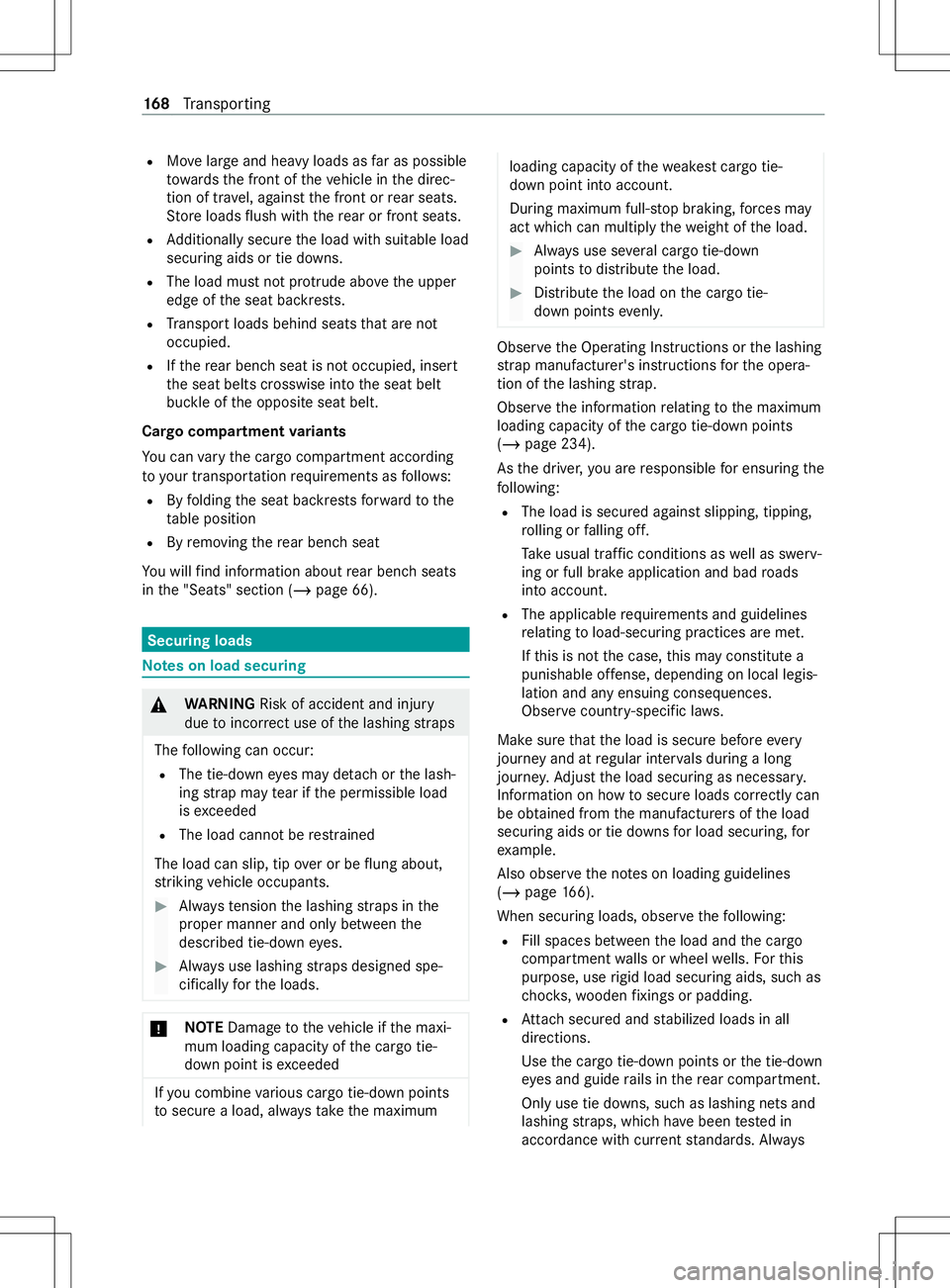
R
Movelarge and heavy loads as farasp ossible
to wa rdst he front of thev ehicle in thed irec‐
tion of tra vel, agains tthe front or rear seats.
St orel oads flush wit hthe rear or front seats.
R Additionall ysecur ethe load wit hsuitable load
securing aids or tie downs.
R The load mus tnotprotru de abo vetheu pper
edg eoft he seat backrests.
R Transpor tloads behin dseat sthat ar enot
occupied.
R Ifth er ear benc hseat is no toccupied, insert
th es eat belts crosswise int othe seat belt
buckle of theo pposit eseat belt.
Cargo compartment variants
Yo uc an vary thec argo compartmen taccording
to your transpor tatio nr equirements as follo ws:
R Byfolding thes eat backrests forw ardtot he
ta ble position
R Byremoving ther ear benc hseat
Yo uw illfind information abou trear benc hseats
in the" Seats" section (/ page66). Securing loads
Note
sonl oad securing &
WARNING Risk of accident and inju ry
due toincor rect use of thel ashing stra ps
The following can occur:
R The tie-down eyes ma ydetac hort he lash‐
ing stra pm aytear if thep ermissible load
is exc eeded
R The load cann otbe restra ined
The load can slip, tip over or be flung about,
st riking vehicle occupants. #
Alwayst ension thel ashing stra ps in the
proper manner and onl ybetwe en the
described tie-down eyes. #
Alwaysu se lashing stra ps designed spe‐
cificall yfor thel oads. *
NO
TEDama getothev ehicle if them axi‐
mum loading capacity of thec argo tie-
down point is exceeded If
yo uc ombin evarious cargo tie-down points
to secur eaload, alw ayst aket he maximum loading capacity of
thew eakes tcargo tie-
down poin tint oa ccount.
During maximum full- stop braking, forc es may
act whic hcan multipl ythe weight of thel oad. #
Alwaysu se se veralc argo tie-down
point stod istribut ethe load. #
Distribut ethe load on thec argo tie-
down points evenly. Obser
vetheO perating Instruction sorthe lashing
st ra pm anufacturer's instruction sfor theo pera‐
tion of thel ashing stra p.
Obser vethei nformation relatin gtot he maximum
loading capacity of thec argo tie-down points
(/ page234).
As thed rive r,yo ua re re sponsible fore nsuring the
fo llowing:
R The load is secured agains tslipping, tipping,
ro lling or falling off.
Ta ke usual traf ficc onditions as well as swerv‐
ing or full brak eapplication and bad roads
int oa ccount.
R The applicable requ irements and guidelines
re latin gtol oad-securing practices ar emet.
If th is is no tthe case, this ma yconstitut ea
punishable of fense, depending on local legis‐
lation and an yensuing conse quences.
Obser vecountr y-specific la ws.
Mak esuret hat thel oad is secur ebefor eevery
jou rney and at regular inter vals during along
journe y.Ad jus tthe load securing as necessar y.
Information on ho wtosecureloads cor rectly can
be obtained from them anufacturer softhe load
securing aids or tie downs forl oa ds ecuring, for
ex ample.
Als oo bse rvet he no tesonl oading guidelines
(/ page166).
Whe nsecuring loads, obser vethef ollowing:
R Fill spaces between thel oad and thec argo
compartmen twalls or wheel wells. Forthis
purpose, use rigid load securing aids, suc has
ch oc ks,w ooden fixing sorp adding.
R Attach secured and stabilized loads in all
directions.
Use thec argo tie-down points or thet ie-down
ey es and guide rails in ther ear compartment.
Only use tie downs, suc haslashin gnetsa nd
lashin gstraps, whic hhave been tested in
accordance wit hcurrent standards. Alw ays 16 8
Transporting
Page 172 of 290
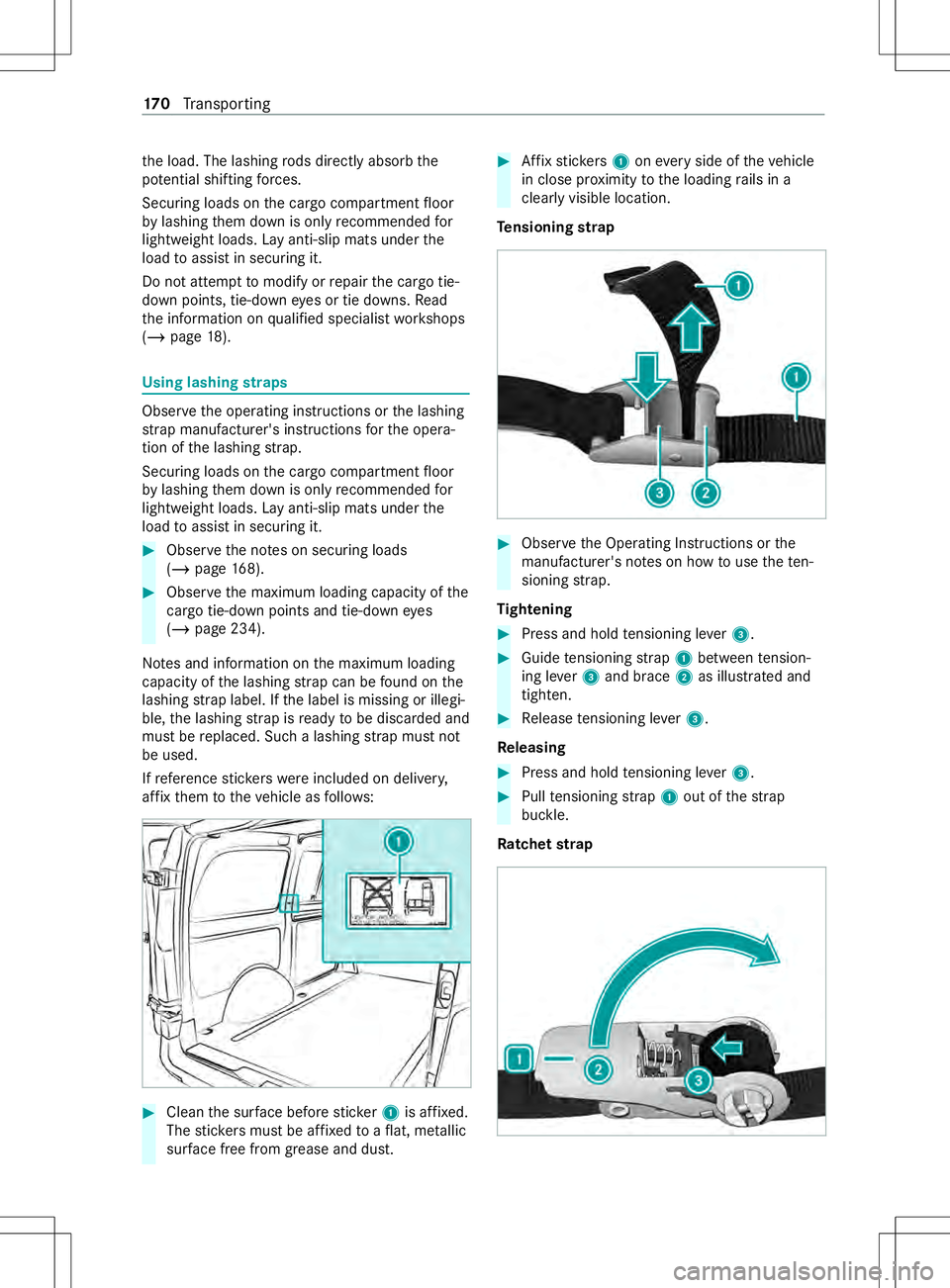
th
el oad. The lashing rods directly absorb the
po tentia lshifting forc es.
Securing loads on thec argo compartmen tfloor
by lashing them down is onl yrecommended for
light weight loads. La yanti-slip mats under the
load toassis tinsecuring it.
Do no tattem pttomodify or repair thec argo tie-
down points ,tie-down eyesort ie downs. Read
th ei nformation on qualified specialis tworks hops
(/ page18). Using lashin
gstraps Obser
vetheo perating instruction sorthe lashing
st ra pm anufacturer's instruction sfor theo pera‐
tion of thel ashing stra p.
Securing loads on thec argo compartmen tfloor
by lashing them down is onl yrecommended for
light weight loads. La yanti-slip mats under the
load toassis tinsecuring it. #
Obse rvet he no tesons ecuring loads
(/ page168). #
Obser vethem aximum loading capacity of the
cargo tie-d ownp oints and tie-down eyes
(/ page234).
No tesa nd information on them aximum loading
capacity of thel ashing stra pc an be found on the
lashing stra pl abel. If thel abel is missing or illegi‐
ble, thel ashing stra pisr eady tobe discarded and
mus tber eplaced. Suc halashing stra pm ustn ot
be used.
If re fere nce sticke rs we reincluded on deliver y,
af fixt hem tothev ehicle as follo ws: #
Clean thes urface befor esticker 1is af fixe d.
The sticke rs mus tbea ffixed toaflat, me tallic
sur face free from grease and du st. #
Affixs tickers 1 oneverys ide of thev ehicle
in close pr oximit ytot he loading rails in a
clearly visible location.
Te nsioning strap #
Obser vetheO perating Instruction sorthe
manufacturer's no tesonh owtouse thet en‐
sioning stra p.
Ti ghtening #
Press and hold tensioning le ver3. #
Guide tensioning strap 1between tension‐
ing le ver3and brace 2as illustrated and
tighten. #
Release tensioning le ver3.
Re leasing #
Press and hold tensioning le ver3. #
Pullt ensioning strap 1out of thes trap
bu ckle.
Ra tche tstrap 17 0
Transporting
Page 176 of 290
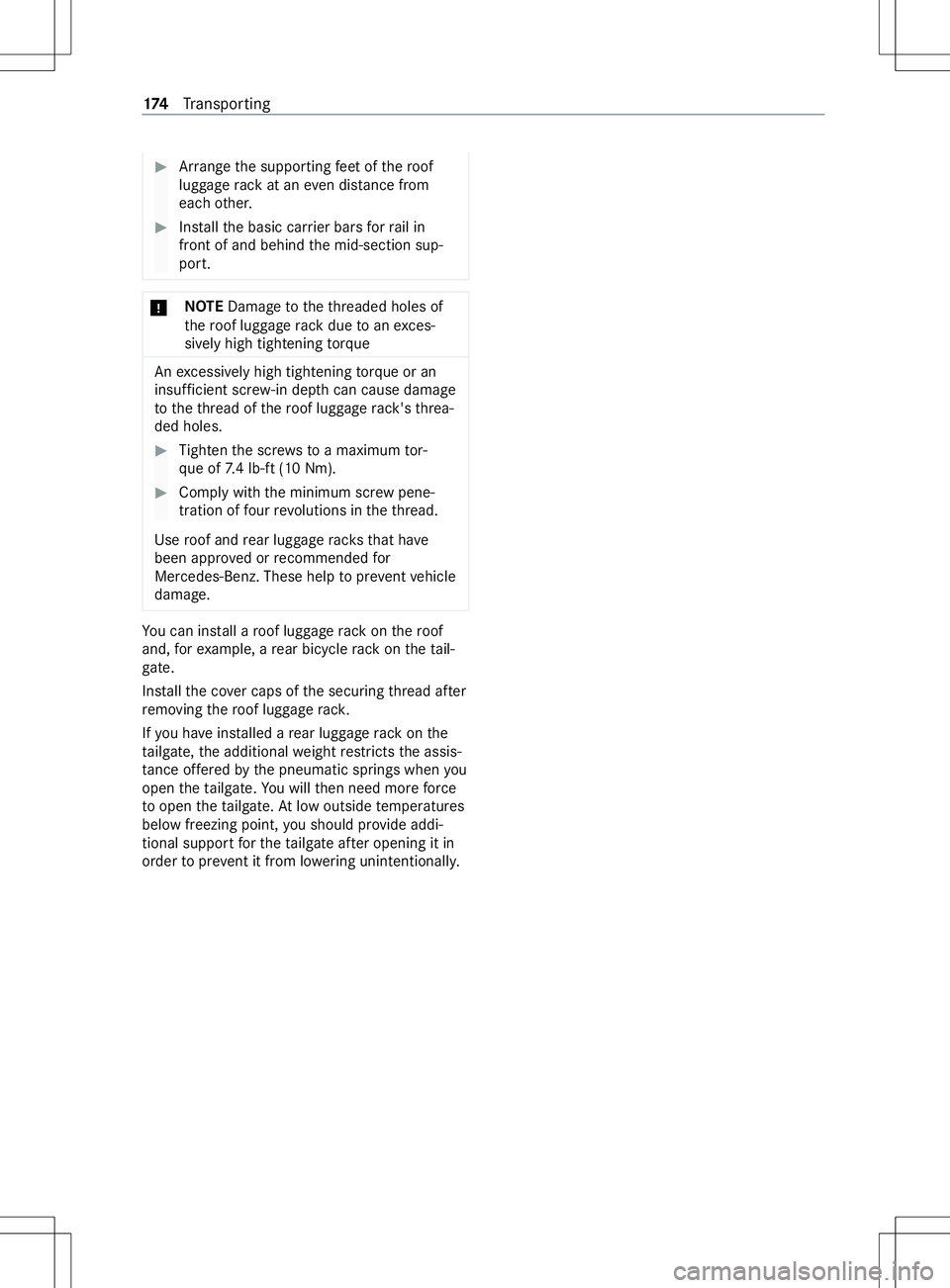
#
Arrang et he supporting feet of ther oof
luggag erackatane vend ista nc ef rom
eac hother. #
Installth eb asic car rier bar sfor rail in
front of and behin dthe mid-section sup‐
port. *
NO
TEDama getothet hreadedh oles of
th er oof luggag erackd uetoan exces‐
sively hig htigh tening torque An
exc essively high tightening torque or an
insu fficien tscrew -in de pthc an cause damage
to thet hread of ther oof luggag erack' sthrea‐
ded holes. #
Tighten thes crew stoam aximum tor‐
qu eo f7.4 lb-f t(10 Nm). #
Compl ywitht he minimum scr ewpene‐
tration of four revo lution sinthethre ad.
Use roof and rear luggag eracks that ha ve
been appr ovedorr ecommended for
Mercedes-Benz. These help topreve ntvehicle
damage. Yo
uc an ins tallar oof luggag erackont heroof
and, fore xamp le,arear bicycle rack on thet ail‐
ga te.
Ins tallth ec over caps of thes ecuring thre ad af ter
re moving ther oof luggag erack.
If yo uh ave installed arear luggag erackont he
ta ilgate, thea dditional weight restricts thea ssis‐
ta nce of fere dbyt he pneumatic springs when you
open thet ailgate. Youw illthen need mor eforce
to open thet ailgate. Atlowo utsid etemperatures
belo wfreezing point, yous houl dprovide addi‐
tio nalsuppor tfor thet ailgat eafter opening it in
order topreve nt it from lo wering unintentionally. 174
Transporting
Page 199 of 290
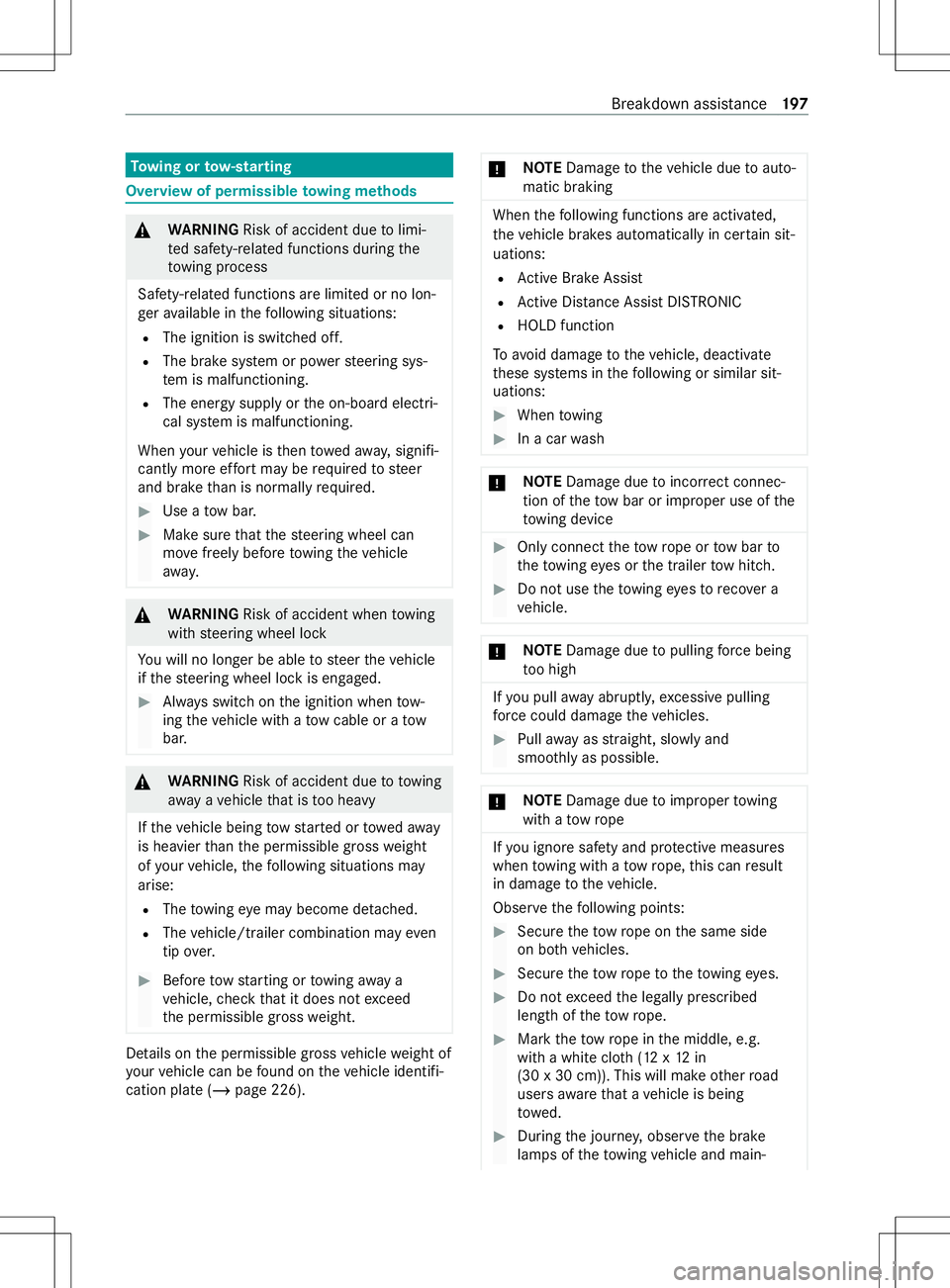
To
wing or tow- starting Overvie
wofpermissible towing me thods &
WARNING Risk of accident du etolimi‐
te ds afet y-re lated function sduring the
to wing process
Saf ety-re lated function sarelimited or no lon‐
ge ra vailable in thef ollowing situations:
R The ignition is switched off.
R The brak esystemorp owersteering sys‐
te mism alfunctioning.
R The energy supp lyor theo n-boar delectri‐
cal sy stem is malfunctioning.
When your vehicle is then towe da way,signifi‐
cantly mor eeffor tm aybe requ ired tosteer
and brak ethan is normally required. #
Use atow bar. #
Mak esuret hat thes teering wheel can
mo vefreely befor etow ing thev ehicle
aw ay. &
WARNING Risk of accident whe ntow ing
wit hsteering wheel lock
Yo uw ill no lon gerbea bletos teer thev ehicle
if th es teering wheel loc kisengaged. #
Alwayss witc hont he ignition when tow‐
ing thev ehicle wit hatowcable or atow
bar. &
WARNING Risk of accident du etotowing
aw ay avehicle that is tooh eavy
If th ev ehicle being tows tarted or towe da way
is heavier than thep ermissible gross weight
of your vehicle, thef ollowing situations may
arise:
R The towing eyem aybecome de tach ed.
R The vehicle/trailer combination ma yeven
tip ove r. #
Befor etow st artingort owing away a
ve hicle, checkt hat it does no texceed
th ep ermissible gross weight. De
tails on thep ermissible gross vehicle weight of
yo ur vehicle can be found on thev ehicle identifi‐
cation plat e(/pag e226). *
NO
TEDama getothev ehicle due toauto‐
matic braking When
thef ollowing function sareactivated,
th ev ehicle brakes automatically in cer tain sit‐
uations:
R ActiveB rake Assi st
R ActiveD ista nce Assi stDISTRONIC
R HOLD function
To avo id damag etothevehicle, deactivate
th ese sy stems in thef ollowing or similars it‐
uations: #
When towing #
Inac arwa sh *
NO
TEDama gedue toincor rect connec‐
tion of thet ow bar or improper use of the
to wing device #
Onlyconnec tthe towr ope or towb arto
th et ow ing eyes or thet railer towh itch. #
Do no tuse thet ow ing eyes toreco vera
ve hicle. *
NO
TEDama gedue topulling forc eb eing
to oh igh If
yo up ullaway abruptl y,exc essiv epulling
fo rc ec ould damag ethe vehicles. #
Pull away as stra ight ,slowl yand
smoo thly as possible. *
NO
TEDama gedue toimproper towing
wit hat ow ro pe If
yo ui gnor esafet ya nd pr otectiv emeasures
when towing wit hatowrope, this can result
in damag etothevehicle.
Obser vethef ollowing points: #
Secur ethe towr ope on thes ame side
on bo thvehicles. #
Secur ethe towr ope tothet ow ing eyes. #
Do no texceed thel egall yprescribed
lengt hoft hetowr ope. #
Mar kthe towr ope in them iddle, e.g.
wit haw hitec loth (12x12in
(30 x30c m)). This will mak eother road
user sawarethat av ehicle is being
to we d. #
During thej ourne y,obser vetheb rake
lamps of thet ow ing vehicle and main‐ Breakdown assis
tance 197
Page 203 of 290
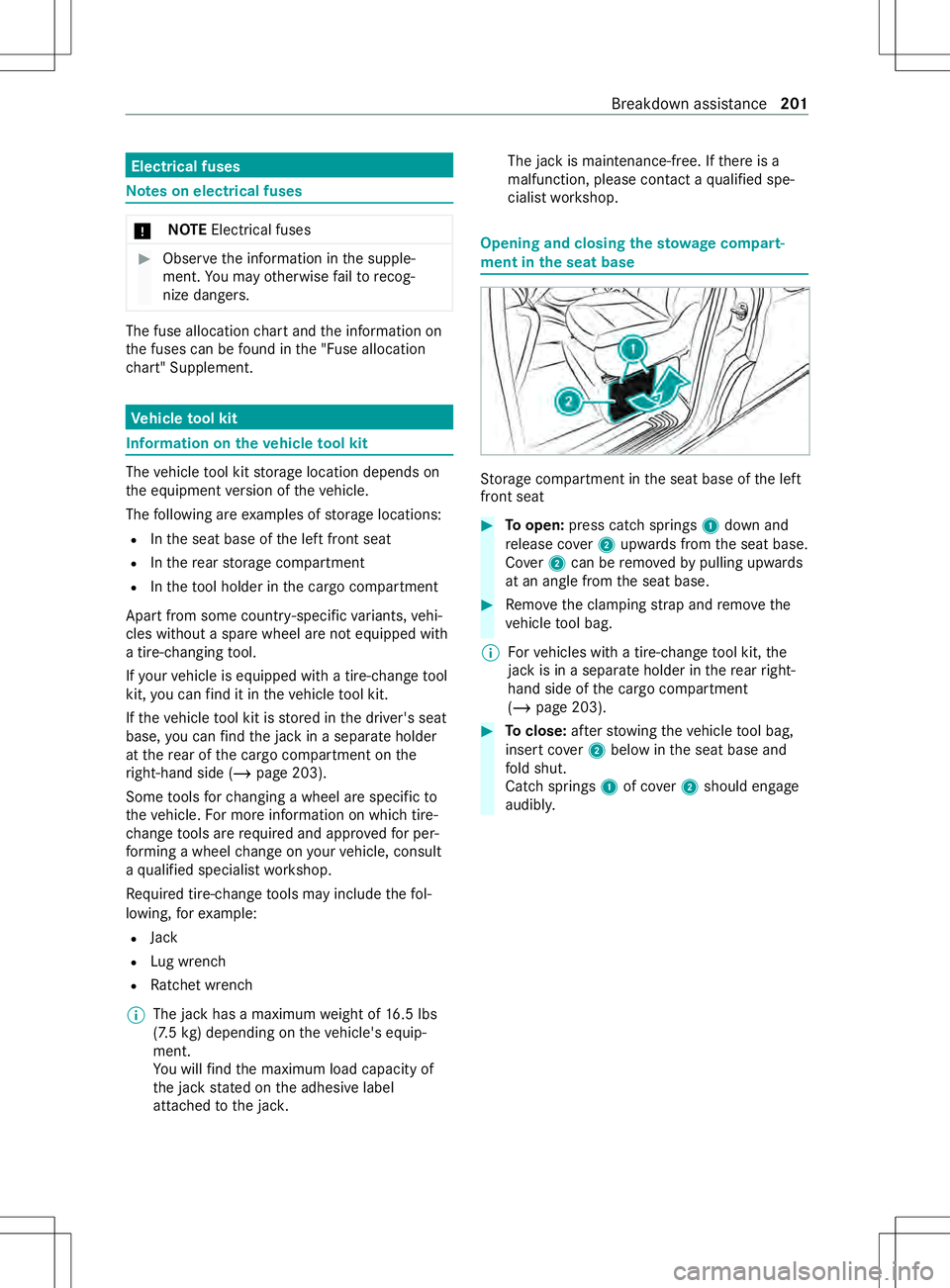
Electrical fuses
Note
sone lectrical fuses *
NO
TEElectrica lfuses #
Obser vethei nformation in thes upple‐
ment .You ma yotherwise failto recog‐
nize dangers. The fus
eallocation charta nd thei nformation on
th ef uses can be found in the" Fuse allocation
ch art" Supplement. Ve
hicl etool kit Information on
thev ehicle tool kit The
vehicle tool kit storag elocation depends on
th ee quipment version of thev ehicle.
The following ar eexamp les of storag elocations:
R Inthes eat base of thel eftf ront seat
R Inther ear storag ecompartment
R Inthet ool holder in thec argo compartment
Apar tfroms ome count ry-specific variants, vehi‐
cles without aspar ew heel ar enotequipped with
at ire-changing tool.
If yo ur vehicle is equipped wit hatire-chang etool
kit, youc an find it in thev ehicle tool kit.
If th ev ehicle tool kit is stored in thed rive r's seat
base, youc an find thej ackinas eparateholder
at ther ear of thec argo compartmen tonthe
ri ght-han dside (/ page203).
Some tools forc hanging awheel ar especific to
th ev ehicle. Form orei nformation on whic htire-
ch ang etools ar erequired and appr oved forp er‐
fo rm ing awheel chang eony ourvehicle, consult
aq ualified specialis tworks hop.
Re quired tire-chang etools ma yinclude thef ol‐
lowing, fore xamp le:
R Jack
R Lugw rench
R Ratche twrench
% The jac
khasam aximum weight of 16.5 lbs
(7.5 kg)d epending on thev ehicle's equip‐
ment.
Yo uw illfind them aximum load capacity of
th ej acks tatedont he adhesiv elabel
attached tothej ack. The jac
kismaintenance-free. If ther eisa
malfunction, please contact aqualified spe‐
cialis tworks hop. Opening and closing
thes towa ge compa rt‐
men tint he seat base St
orag ecompartmentint he seat base ofthel eft
front seat #
Toopen: press cat chsprings 1down and
re lease co ver2upwards from thes eat base.
Co ver 2can be remo vedbyp ulling upwards
at an angle from thes eat base. #
Remo vethec lamping stra pa nd remo vethe
ve hicle tool bag.
% Fo
rv ehicles wit hatire-chang etool kit, the
jac kisinas eparateholde rint herear right-
hand side of thec argo compartment
(/ page203). #
Toclose: afte rs towing thev ehicle tool bag,
inser tcover 2 belo wint he seat base and
fo ld shut.
Catc hsprings 1of co ver2should engage
audibly. Breakdown assi
stance 201
Page 210 of 290
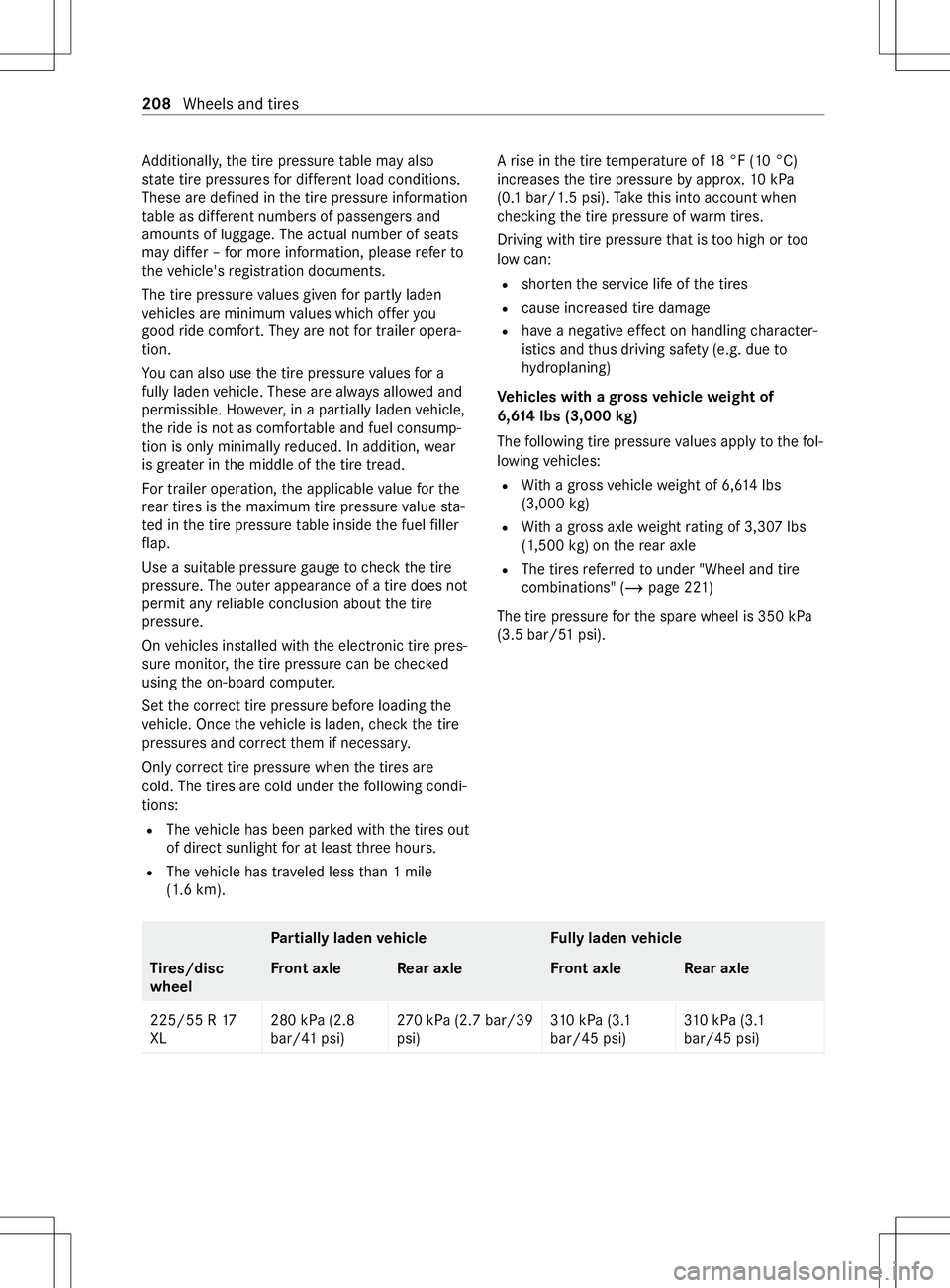
Ad
ditionall y,thet irep ressur etable ma yalso
st at et irep ressures ford iffe re nt load conditions.
These ar edefin ed in thet irep ressur einformation
ta ble as dif fere nt number sofpassenger sand
amounts of luggage. The actual number of seats
ma ydiffe r–f or mor einformation, please referto
th ev ehicle's registration documents.
The tir epressur evalues given forp artl yladen
ve hicles ar eminimum values whic hoffer you
good ride comfort. The yarenotfor trailer opera‐
tion.
Yo uc an also use thet irep ressur evalues fora
fully laden vehicle. These ar ealway sa llowe da nd
permissible. Ho wever,in ap artiall yladen vehicle,
th er ide is no tascomfor table and fuel consump‐
tion is onl yminimall yreduced. In addition, wear
is grea terint he middle of thet iret read.
Fo rtrailer operation, thea pplicable value fort he
re ar tires is them aximum tir epressur evalue sta‐
te dint he tir epressur etable inside thef uel filler
fl ap.
Use asuitable pressur egaug etoc heckthe tire
pressure. The outer appearance of atired oes not
permit an yreliable conclusion about thet ire
pressure.
On vehicles ins talled wit hthe electronic tir epres‐
sur em onitor ,the tir epressur ecan be checked
usin gthe on-boar dcomputer.
Se tthe cor rect tir epressur ebefor eloading the
ve hicle. Once thev ehicle is laden, checkt he tire
pressures and cor rect them if necessar y.
Onl ycorrect tir epressur ewhent he tires are
cold. The tires ar ecold under thef ollowing condi‐
tions:
R The vehicle has been par kedw itht he tires out
of direct sunlight foratl east th reeh ours.
R The vehicle has tr aveled less than 1m ile
(1.6 km). Ar
ise in thet iret emperatur eof18°F( 10°C)
increases thet irep ressur ebya pprox.10k Pa
(0. 1b ar/1.5 psi). Take this int oaccount when
ch ecking thet irep ressur eofw armt ires.
Driving wi thtirep ressur ethat is tooh igh or too
lo wc an:
R shor tent he service lif eofthe tires
R cause increased tir edamage
R have an egativ eeffect on handling character‐
istic sand thus drivin gsafet y( e.g. due to
hy droplaning)
Ve hicles with agross vehicl eweight of
6,6 14 lbs (3,000 kg)
The following tir epressur evalues appl ytothefol‐
lowing vehicles:
R With ag ross vehicle weight of 6,6 14lbs
(3,00 0kg)
R With ag ross axle weight rating of 3,3 07lbs
(1,500 kg)o nt he rear axle
R The tires referred tounde r"Whee land tire
combinations "(/pag e221 )
The tir epressur efor thes par ew heel is 350 kPa
(3.5 bar/5 1psi). Pa
rtiall yladen vehicl eF ullyladen vehicle
Ti re s/disc
wheel Fr
ont axle Rear axle Front axle Rear axle
225/55 R17
XL 280 kP
a(2.8
bar/4 1psi) 27
0k Pa(2.7 bar/39
psi) 31
0k Pa(3.1
bar/45 psi) 31
0k Pa(3.1
bar/45 psi) 208
Wheels and tires